Thermal ageing in components such as power inductors has become an important concern as electronics become smaller and more power-intensive. The performance and lifespan of inductors used in power applications, such as DC-DC converters and automotive systems, are impacted by this phenomena, which is brought on by prolonged exposure to high temperatures.
To combat thermal ageing, Würth Elektronik has developed high-temperature inductors with improved reliability and performance. Find out more of the Würth Elektronik inductors’ features and how they can be used in various applications by reading this article.
What Causes Thermal Ageing?
The term “thermal ageing” describes how heat gradually erodes the magnetic core material in power inductors. High-temperature materials, like the iron alloys employed in the core, lose their magnetic characteristics when subjected to temperatures exceeding 100°C. This worsens the degeneration by raising internal temperatures, decreasing efficiency, and increasing core losses. Due to their frequent exposure to heat cycling, high-current inductors exhibit an especially noticeable ageing impact.
Mechanism of Thermal Ageing
The majority of thermal ageing in power inductors happens in the core. The core of moulded power inductors is composed of iron alloy or another compacted magnetic material (read below). This core’s qualities deteriorate with repeated exposure to heat. The inductor’s capacity to handle high currents may deteriorate with age, particularly in high-stress operating environments. The inductor may experience increasing heat generation and a resultant decline in performance over time. Systems like DC-DC converters may become less efficient as a result of this deterioration, which could result in failure.
Magnetic Materials for Power Inductors
Various magnetic materials are available for inductor manufacturing, including traditional ferrites (Mn-Zn, Ni-Zn, Ni-Cu-Zn), soft magnetic metals (Si-Fe, amorphous, nanocrystalline), and powdered metal alloys (Fe-Si, Fe-Ni, Fe-Co). While metal alloy powdered cores have high permeability, their isolated grain structure introduces nonmagnetic gaps that reduce effective permeability (μe) to below 200. Ferrites and soft magnetic metals, which have high permeability (>1000), require gapping, but this tilts the hysteresis curve and increases the current needed to reach saturation.
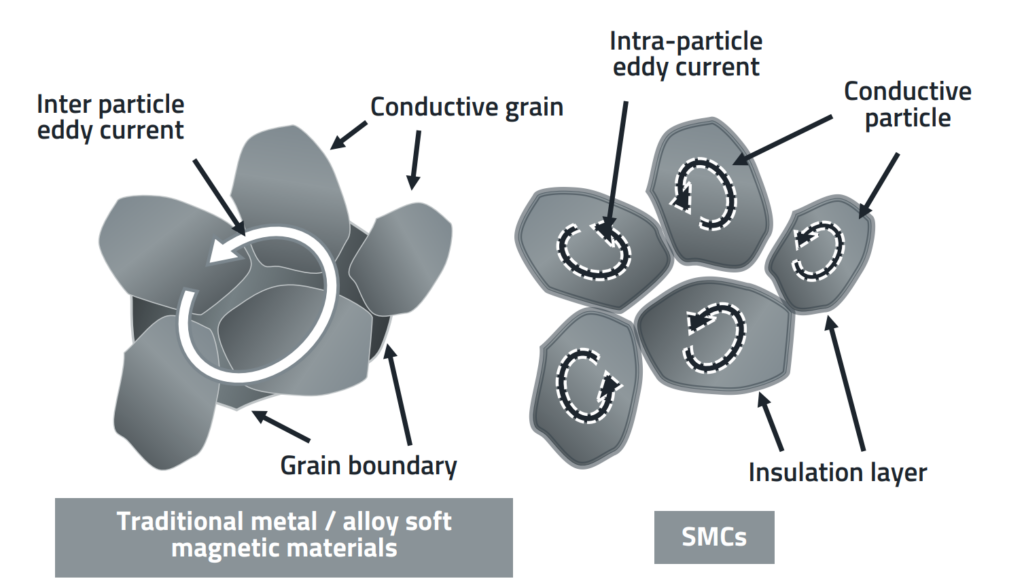
Powdered magnetic alloys offer two to three times higher saturation flux density compared to ceramic materials, making them suitable for various applications. These alloys are coated with an insulating layer and bonded with a polymer to form soft magnetic composites (SMCs). This structure minimises eddy current losses and provides a uniformly distributed gap along the magnetic path, making SMC cores ideal for high current and high frequency operations.
In SMCs, eddy currents are reduced due to the insulation between particles, improving performance in high-frequency applications compared to ferrites and conductive soft metals. SMCs also exhibit better DC bias handling and temperature stability, making them excellent for high current and power density applications. However, long-term temperature stability can be compromised when exposed to high temperatures for extended periods while operating at high frequencies.
Thermal Ageing in Moulded Power Inductors
Long-term exposure to high temperatures causes moulded power inductors to age thermally, which progressively reduces their functionality. Power inductors are commonly employed in high-current applications, and dependable operation requires a grasp of thermal ageing.
Thermal Ageing Effect in Moulded Material Mixtures
As per Würth Elektronik’s data, higher power losses, increased self-heating, increased electromagnetic emissions (EMI), and a decline in the quality factor Q at high frequencies are a few signs of thermal ageing. One observable occurrence that may be connected to the decline in performance is changes in the look of the core material. The core material, exposure duration, and core temperature all have a direct impact on how much these modifications vary. Different moulded power inductors have been tested at 200°C for 1000 hours in order to have a better knowledge of the first effect of thermal ageing. The below images illustrate how the material’s appearance is generally affected by increasing temperatures.
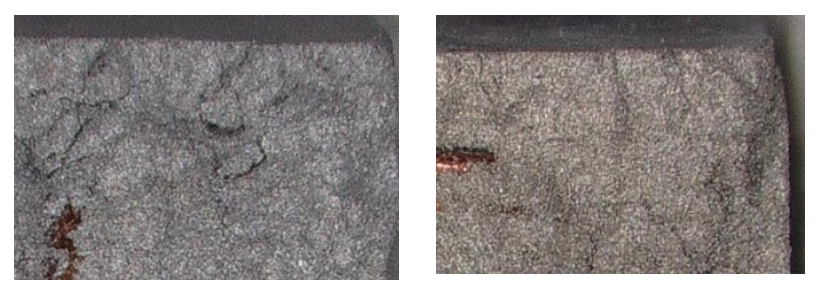
The binders and insulating layer of the iron powder degrade over extended periods of time at high temperatures, lowering the material’s resistivity. AEC-Q200 qualified moulded power inductors are available from certain manufacturers; yet, a qualified inductor with and without a robust thermal ageing enhancement differs greatly. As seen in the picture below, this becomes clearer when a closer examination of the tested components is conducted.
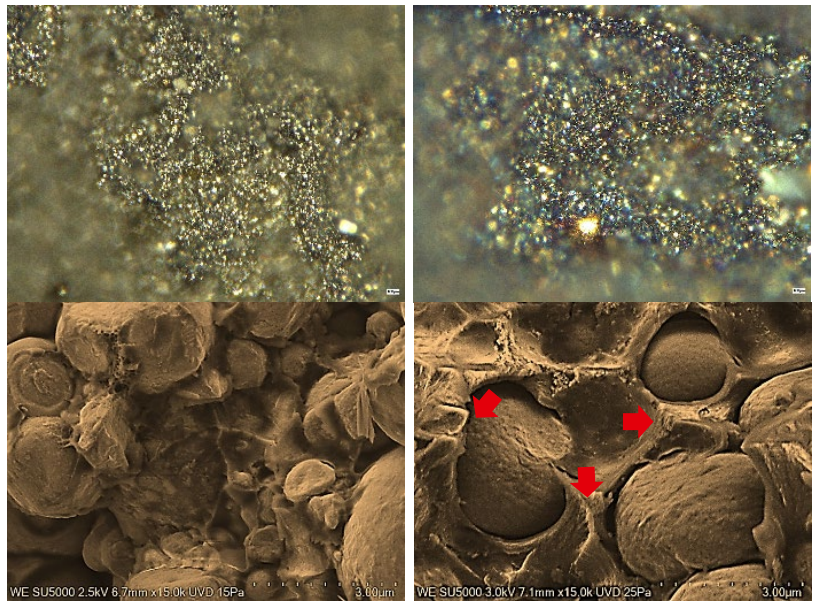
The discolouration effect seen in the first image is a result of the coating material combining and the inter-particle insulation of the components burning. The insulating layer on the particle surface and the tiny air gaps in the SMC material are reduced at higher temperatures because the components appear to seep into the powder particles from the boundary.
Both illustrations present the effects of elevated temperatures on the core material, despite the inducer being approved for AEC-Q200 grade 0 (-55°C to +150°C).
How Thermal Ageing Impacts the System Performance
Thermal ageing can have significant implications for systems that rely on consistent power delivery, such as automotive, industrial, and telecom sectors. The capacity of inductors to withstand transients and peak currents decreases with age. If left unchecked, this could lead to problems with voltage regulation, inefficiency in power converters, or even total system failure.
Würth Elektronik’s Case Study: Test on a Power Inductor
Würth Elektronik tested their new WE-LHMI moulded power inductors, rated at 10 µH, against popular competitors of similar size and inductance. A total of 100 samples were subjected to 200°C in a climatic chamber for 1000 hours, with periodic measurements of L and Q values. The inductors meet AECQ grade 0 and grade 1 qualifications, with a maximum operating temperature above 150°C.
As shown in the graph below, the 10 µH inductance remained within a ±20% tolerance at 100 kHz throughout the test, highlighting that standard datasheet measurements may not reveal performance changes.
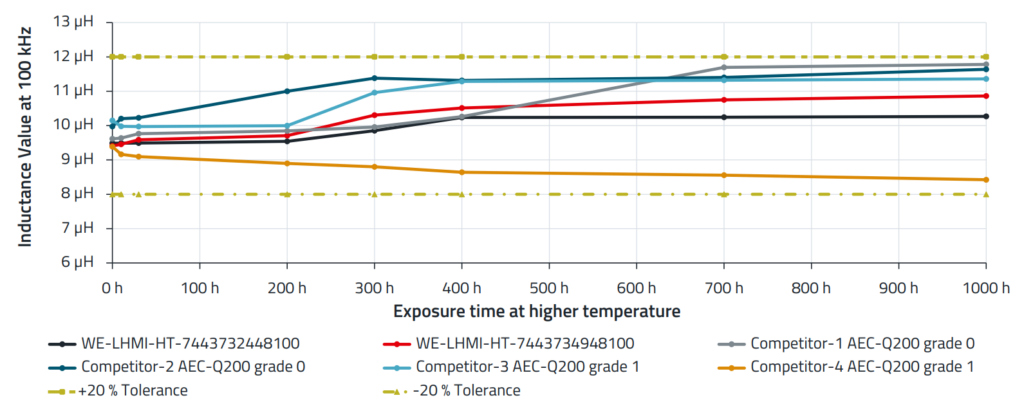
However, the following image indicates that the quality factor Q decreases with prolonged high temperatures, even for inductors with excellent AEC-Q200 ratings, despite stable inductance values.
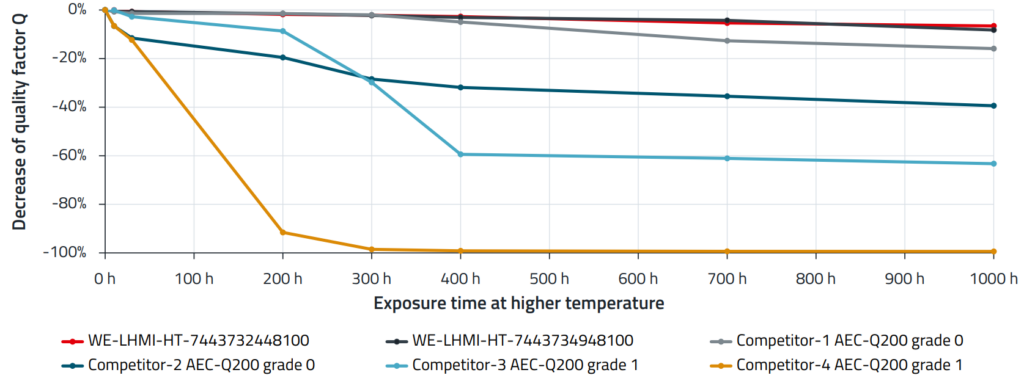
Their WE-LHMI power moulded inductors exhibit stability over time, in contrast to some competitor inductors that exhibit a constant decline in Q value. Unlike rivals that encounter rising operating temperatures, this stability guarantees improved efficiency and long-term reliability in high-temperature applications.
Q values and L measurements are nearly in line at low frequencies, but there are noticeable performance decreases above 100 kHz.
How to Mitigate Thermal Aging in Power Inductors?
- Material Selection
One of the most effective ways to reduce thermal ageing is to use high-performance core materials. For example, materials with higher Curie temperatures, such as improved iron alloys, can maintain their magnetic properties for longer periods under heat stress. - High-Temperature-Resistant Inductors
Advanced inductors, like Würth Elektronik’s WE-MAPI and WE-LHMI series, are designed to withstand continuous operation at temperatures up to 150°C. These components, qualified to AEC-Q200 standards, demonstrate high resilience against thermal ageing. After 1000 hours of testing at 200°C, these inductors show minimal performance degradation. - Thermal Design
Proper thermal management in the design phase can also extend the life of inductors. Effective heat sinking, airflow optimisation, and circuit placement all play roles in preventing components from overheating.
Choose Long-Term Reliability with Würth Elektronik
Modern design practices place a strong emphasis on choosing components with demonstrated thermal ageing resistance because of how important thermal stability is. Designers can guarantee long-term reliability, lower maintenance costs, and prevent unplanned system outages by utilising high-temperature-rated inductors.
Würth Elektronik is one of the few suppliers that offers inductors with high-temperature rating. Their line is designed to meet the highest requirements in industrial, automotive, and power applications and is ready to withstand the rigours of thermal ageing.
For further details, check Würth Elektronik’s comprehensive resource on thermal ageing here.











